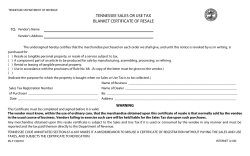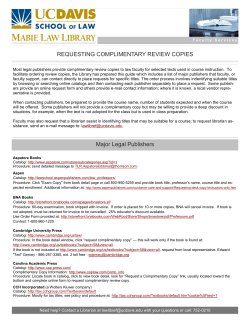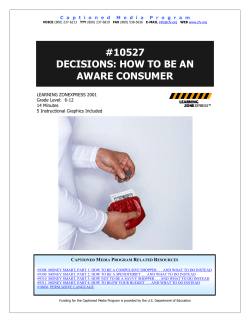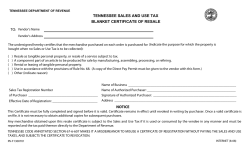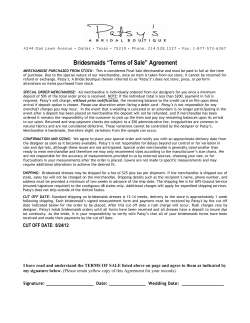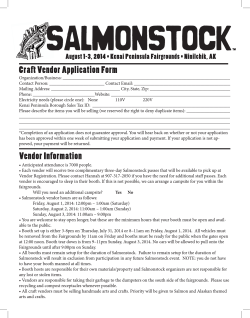
How to Develop A Reverse Logistics Strategy Eight tactics to try
How to Develop A Reverse Logistics Strategy Eight tactics to try By Curt Barry December 2003 Catalog Success Magazine Multichannel industry leaders such as Cabela’s, Talbots, Eddie Bauer, Neiman Marcus, Nordstrom, Lands’ End and L.L. Bean have established themselves as the standard-setters for returns processing, allowing customers the flexibility of returning goods with a no-quibble guarantee. But there’s a downside to a liberal returns policy: Companies have seen return rates increase every year for the past 10 years. For example, $5 of every $100 worth of goods purchased on the Web are returned, compared to $6 for traditional retailers, according to The Boston Consulting Group and Shop.org. And for many merchandise categories, returns rates are much higher (see sidebar “Selected Returns Rates by Merchandise Category,” pg. 3). Moreover, the study found that 40 percent of respondents said they would purchase more online if they had an easier way to deal with returns. Indeed, product returns present numerous problems for any merchant, including high costs to process, a receiving backlog, space considerations in your distribution center (DC) and the considerable length of time it can take for customers’ accounts to be credited. You also incur costs for re-packaging, preparing products or, in the case of apparel, possible rework (e.g., steaming garments, folding, replacing buttons). To make matters even more problematic, many catalogers lack adequate visibility of incoming returned goods, and therefore, are unable to appropriately plan for staffing and other resources needed to process the returns efficiently. (Companies that follow best practices generally process customer returns within 48 hours to 72 hours of receipt and credit the customer within seven days of receiving the return). This article’s purpose is to define and identify the benefits to reverse logistics services, and the steps involved in developing an effective and efficient strategy for your catalog. Benefits of Reverse Logistics Services Numerous companies, including Newgistics, UPS and FedEx, offer services designed to help multichannel merchants deal with the increasing number of returns and the high cost to process them. These service providers and others offer value-added plans for returns processing, and they provide technology that allows you to generate postage-paid labels to facilitate easier customer returns. (Typically the postage-paid label is deducted from the customer’s refund). The labels also enable visibility into goods being returned to you in advance of the shipment, thus enabling you to achieve better distribution resource planning. < Definition > Reverse Logistics According to the Reverse Logistics Executive Council (www.rlec.org), “reverse logistics is the process of moving goods from their typical final destination to another point, for the purpose of capturing value otherwise unavailable, or for the proper disposal of the products.” Customers can complete the enclosed returns form, package it with the merchandise being returned, and then drop the entire package off at a designated pick-up location such as the U.S. Postal Service (USPS), FedEx or UPS. Such third party services transmit updates to the customer file of the multichannel company in advance of the returned product being received. Catalog Success—December 2003 Page 1 These types of return labels store all the appropriate information concerning the order and customer information. Once you get the returned item back, the merchandise is processed. Depending on your business rules and logic, the item can be given a disposition such as return to vendor, saleable or destroy etc. From there, the items can be sorted based on the disposition. Many vendors offer some limited re-work and sorting down to the item level, and then aggregate it to save on freight costs back to you. This also allows you to get and process the goods much easier when the shipments arrive at your DC. Depending on the disposition, the merchandise can be re-routed, based on your stated business logic. For example, goods can be transferred to a liquidation or clearance center, disposed of due to damage or returned to your vendor. Typically third-party companies handle either all or part of the returns process, based on how much control you want to hand over. The visibility of returns these companies offer also allows you to get the return information much quicker, and it allows you to process the refund, replacement or exchange much faster. Following are some of the reverse logistics services currently available: The SmartLabel program from Newgistics allows customers to drop off returns at any USPS location. The postage-paid label amount is then deducted from the customer’s return. Catalogers either can pass off all returns-processing functions to Newgistics or retain some of the function in-house. Current Newgistics users include Neiman Marcus, Chef’s Catalog, Horchow, Abercrombie & Fitch, Eddie Bauer, J. Crew, Speigel, Newport News, and Frederick’s of Hollywood. Contact: (512) 225-6000; www.newgistics.com UPS can integrate its returns labels to your Web site allowing your customers to initiate the returns process online from your site. This allows you to see in advance the items being returned to you. The customer then can print a UPS label directly from your Web site, apply the label to the returning package, and either call for a pick-up or drop it off at a UPS location. UPS also offers product testing and disposition, refurbishing, re-packaging, product disposal, and technical repair services. Contact: (800) 742-5877, www.ups.com The new Consolidated Returns Service from FedEx allows customers to drop off returns at any FedEx location. The company uses bar-coding to provide data visibility for the entire returns process. Returns are consolidated at regional FedEx facilities based on merchant name and product disposition code, and then reshipped. Actual inbound freight savings vary, of course, but one large company with whom I talked reported savings of at least 15 percent. Contact: (800) 222-7657, www.fedex.com Catalog Success—December 2003 Page 2 USPS recently launched Parcel Return Services, a two-year pilot program in which direct marketers can retrieve returned items directly from the Postal Service’s delivery units or Bulk Mail Centers (BMC). Customers use a prepaid return label that shippers can place in the original packages, mail to customers, or make available to customers for download via the Internet. The price for pieces picked up at the post office nearest the customer is $2 per parcel, according to the USPS. Prices for pieces picked up at a BMC depend on the package weight and the distance traveled. USPS says that by picking up parcels at the BMC, merchants can save $0.24 to $1.51 per parcel off existing rates. Contact: your local post office, or www.usps.gov Steps to Success Before selecting a third-party vendor to assist with your returns processing, here are eight strategies to help guide your way. #1 Analyze your returns process and the reasons for returns; then develop detailed returns reporting. Discern the major reasons for returns, i.e., products were depicted incorrectly in the catalog or on your Web site, product quality or packaging is poor, or simply customer choice. Selected Return Rates By Merchandise Category Business products……………<1% to 5% Hard-goods gifts………………5% to 9% Home décor………………………5% to 10% High-tech products………… 5% to 20% Casual apparel…………………10% to 20% Shoes……………………………… 10% to 30% Fitted apparel………………… 20% to 30% High-fashion apparel……… 25% to 40% Source: F. Curtis Barry & Company #2 Develop a detailed analysis of your current returns-processing costs. This will take some work on your part, and your catalog management system — whether developed inhouse or as a commercial system — may not be able to offer much help. Why? Generally speaking, such systems aren’t robust or streamlined enough to process customer and inventory transactions efficiently. But it’s important to try to get a handle on your costs. Here’s why: Returns usually cost more to process than it costs to take and process the initial orders. Plus, your catalog suffers the margin loss from returns. #3 Analyze your customers’ expectations in terms of speed for processing the returns and issuing credit. How well will the returns service treat your customers if there’s a need for interaction? Are the employees of the service customer friendly? Be sure the vendor has the capacity to handle your operations. Ask, for example, if the vendor has handled your type of product before. #4 Factor returns into your initial buying plans, and count on resalable returns to fill customer orders. Don’t let resalable returns pile up. Ship them back to your DC quickly so they can be used to fulfill new orders. If you hold onto salable goods too long, you may create backorder problems that can run from $7 to $12 per backordered unit of merchandise. Catalog Success—December 2003 Page 3 #5 Determine your requirements, functions and business metrics. What functions and data will you expect from the vendor, and what will you keep in-house? Understand the complexities involved with receiving data from a third-party vendor. Ask, for example, how often will data be passed to you and in what format. Also, how quickly and easily can the service import data for review? #6 Evaluate all your options for returns processing before selecting a third-party vendor. Carefully scrutinize vendors’ services before off-loading the returns process. For instance, discern how well they’re equipped to handle highly fragile items, high-ticket merchandise such as jewelry, or items that are perishable or otherwise time-sensitive. Ask for referrals from other catalogers. #7 Compare your business requirements against all viable options, and check references from all vendors. Ask the tough questions, and understand what their clients’ expectations were compared to the current service levels. Keep in mind that you’ll be handing over some operational control to this vendor, as well as some communications from your customers. Are you ready for it as a company? #8 Evaluate all the alternatives and costs in conjunction with product turnaround time and crediting customers, whether it’s handled internally or from third-party options. Remember, the returns process, if handled poorly, can erode customer confidence and loyalty. Customers expect the same speed and courteous service in the return process as they got when they were ordering from you in the first place. Conclusion Before outsourcing your returns processing, understand the challenges. Analyze your cost per return and track it over time for peak and non-peak seasons. Fully evaluate all third-party options, and keep in mind that this critical task can help retain customers or compel them to shop elsewhere. Curt Barry is the president of F. Curtis Barry & Company, a Richmond, VA-based firm that specializes in operations and fulfillment consulting for catalog and e-commerce companies. You may contact him directly at (804)740-8743; through his Web site at w w w .fcbco.com; or by e-mail at cbarry@fcbco.com. Catalog Success—December 2003 Page 4
© Copyright 2025

